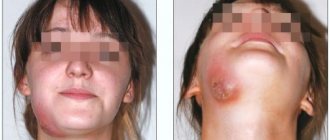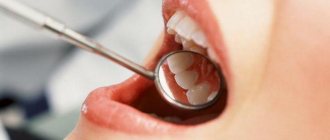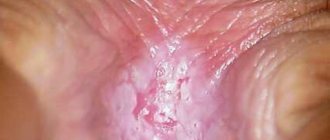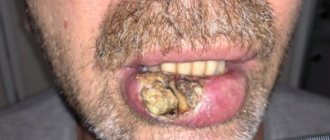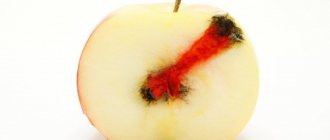Causes of stomatitis
In children, as in adults, stomatitis can be caused by viruses, fungi, bacteria, allergies and injuries. About six months after birth, the child loses the immunity received from the mother, the protective power of the immune system changes, and the child’s body becomes more susceptible to infections. The oral mucosa in children is more delicate and easier to injure; children also more often “bite” their cheeks after dental treatment due to a temporary loss of sensitivity after anesthesia, which causes traumatic stomatitis.
Children are not always motivated to brush their teeth, so poor hygiene can also cause stomatitis.
With the following diseases, stomatitis is observed in children much more often: chronic tonsillitis, diabetes mellitus, heart defects, chronic hepatitis.
What should the first brush be?
Dentists recommend switching to brushing with a toothbrush when baby teeth are at least halfway through. Your first toothbrush should have a compact head and synthetic bristles. In addition to the usual toothbrush, you can use a silicone finger brush: it massages the gums and relieves itching.
4 principles for choosing your first toothbrush:
- The head of the brush should be small and cover two teeth, no more. It will be very difficult to thoroughly remove plaque with a brush with a large head due to its clumsiness.
- The brush head should have silicone pads to make cleaning safe. For babies under one year old, a protective silicone ring (limiter) will not be superfluous.
- The bristles should be soft, thick and short.
- The handle of the brush should be comfortable for both the child and the parents.
From the age of 1 year, it is important to motivate children and fuel their interest in the cleaning process. Research has shown that using electric toothbrushes can be a way to build motivation. In addition, switching to an electric device improves oral hygiene compared to a manual brush: the amount of cariogenic microflora in saliva is reduced, and the risk of developing caries is reduced.
An electric toothbrush at an early age will allow the child to get used to the vibrations in the mouth, and it will be more convenient for parents to reach the distant teeth.
3 principles for choosing your first electric toothbrush:
- For children under 5 years old, it is recommended to choose models with extra soft or soft bristles.
- If the first electric brush has a bright design depicting fairy tale or cartoon characters, the child will form a pleasant association with brushing his teeth.
- The size of the brush head should not exceed 2 cm, and the handle should be rubberized. This way, the child will gradually begin to pick up the brush on his own, and the small head will allow him to brush his teeth more thoroughly.
CURAPROX Curakid Baby (0 to 4 years)
CS Medica CS-561 Kids (from 1 to 5 years) Yellow
Mega Ten Kids Sonic Kitten
Hapica Baby DBB-1Y (from 1 to 6 years)
Classification of HRAS (chronic recurrent aphthous stomatitis)
| CLASSIFICATION | A COMMENT | ||
| classification: | According to the degree of damage to the mucous membrane: | a comment: | 1) Superficial (catarrhal, fibrinous) 2) Deep (ulcerative, necrotic) |
| classification: | According to the clinical course: | a comment: | 1) acute 2) chronic |
All types of stomatitis occur in children, but the most common are: herpetic, candidal and traumatic stomatitis.
Acute herpetic stomatitis
It occurs most often, and mainly affects children from 10 months to 3 years.3 The appearance of rashes is preceded by inflammation of the lymph nodes.
With a mild form
In acute herpetic stomatitis, the temperature rises to 37-37.5°C, the general condition is satisfactory, slight swelling and redness may occur on the gums, then up to six blisters appear, which burst with the formation of painful aphthae surrounded by a red rim.
Afta is a round-shaped erosion. Aphthae may merge together. The rash appears once, and after 1-2 days the erosion gradually heals.
Moderate form
Acute herpetic stomatitis is characterized by deterioration of the child’s well-being, weakness, and headache. The child is capricious, has no appetite, the lymph nodes are enlarged and painful, the temperature rises to 38-39°C, the symptoms resemble ARVI. The oral mucosa is swollen, reddened, rashes appear (bubbles, then erosions) of 10-15 pieces, and often there are rashes on the face. Salivation increases, and gingivitis appears (inflammation of the gums, accompanied by bleeding). The rash may appear several times, i.e. after the old ones heal, new ones appear. Healing of erosions takes up to 4-5 days. Bleeding gums and swollen lymph nodes persist for some time after the erosions have healed.
Severe form
It begins as an acute respiratory viral infection, there is pain in the muscles, joints, tachycardia and bradycardia (increased and slow heartbeat), and nosebleeds may even be observed. In this form, the temperature is high up to 40°C, gingivitis is pronounced, the mucous membrane is bright red, swollen, the child’s lips are dry, the mucous membrane of the eyes is swollen, reddened. The rashes constantly appear again, their number can reach 100. Rashes often appear around the mouth, on the eyelids, on the mucous membranes of the eyes, between the fingers, on the earlobes. Simple gingivitis turns into ulcerative (a more severe form of gum inflammation, with the formation of ulcers), salivation increases, and bad breath appears. Recovery is long and hospitalization is often required.
Diagnosis of oral candidiasis
Candidiasis (thrush) of the oral cavity can be detected during an examination by a dentist if the patient has characteristic complaints. The doctor examines the condition of the oral mucosa, examines scrapings, and carefully examines the hair and skin. If you have oral candidiasis, you also need a blood test to check your glucose levels and rule out diabetes. The sooner you detect the presence of this infection, the easier it will be to get rid of it, so you should not delay diagnosis just because the symptoms do not cause you discomfort.
Enteroviral vesicular stomatitis (arm - leg - mouth)
Caused by enteroviruses. It also occurs in adults, but in 95.7% of cases children are affected.6 It is characterized by seasonal occurrence (summer - autumn) and group incidence.4 It is observed mainly in children under 10 years of age. Vesicular stomatitis is contagious, so it is recommended to use separate utensils and hygiene products. Characteristics for this disease: temperature 37.5-38, weakness, headache, muscle pain, rash on the palms, soles, as well as blisters on the hard palate and pharynx, which then turn into erosions that are almost not painful.
Factors influencing the occurrence of the disease
Candida bacteria live in the body of almost every person, but they do not always lead to the development of thrush. The following factors can provoke the disease in a child:
- previous colds, acute respiratory viral infections;
- internal chronic diseases;
- diabetes;
- appearance of the first teeth.
External factors also influence the development of fungus, such as:
- contacts of the baby with infected adults;
- artificial feeding;
- prematurity;
- toys, household items with fungus settled on them;
- poor hygiene by a nursing mother.
Acute pseudomembranous candidal stomatitis (thrush)
Acute pseudomembranous candidal stomatitis (thrush) occurs:
- Light shape
- Medium-heavy forms
- Severe form
The main symptom of the disease is a white or yellow coating.
With a mild form
The plaque is located in islands, most often on the tongue and cheeks. Children are restless, sleep poorly, and suck the breast sluggishly. Older children may complain of a burning sensation. The plaque is easily removed; underneath there is a bright red mucous membrane. The disease lasts no longer than 7 days.5
Moderate form
The plaque is located on the cheeks, tongue, hard palate, and mucous membranes of the lips. Under the plaque, erosions form, which sometimes bleed. The plaque is more difficult to remove. Lymph nodes are sometimes enlarged and painful. The duration of the disease is 10-15 days, there are relapses.
Moderate form
The plaque is dirty gray, almost cannot be removed, and is located on the tongue, cheeks, soft palate, tonsils, pharynx, and mucous membranes of the lips. Cheilitis appears in the corners of the mouth - inflammation of the lips. The oral mucosa is dry and inflamed. The child’s health is impaired, the child refuses to eat, and the temperature rises. Lesions in the genital area, neck folds, and between the fingers are also common. The disease is long-term, with frequent relapses.
Dangers of candidiasis for a newborn
Candidiasis can occur in simple and complex forms. And depending on the degree, it contains certain dangers:
- in severe forms of thrush, the fungus can reduce immunity and disrupt the gastrointestinal tract;
- candidiasis in a girl can spread to the vaginal mucosa, creating the risk of a pathology called synergy - fusion of the labia or vaginal mucosa;
- a mild form of thrush, in which it is enough to treat the plaque, usually does not pose any danger;
- with moderate thrush, inflammation forms under the white coating, which begins to bleed during treatment; this form brings additional discomfort and pain to the child; in the absence of proper treatment, the disease can become more severe;
- in severe cases of the disease, the fungal infection spreads throughout the entire oral cavity; in addition to pain and discomfort, the child may have a fever; Difficulties with swallowing can lead to the baby refusing not only food, but also water, which leads to rapid dehydration; this condition is life-threatening for the child, so its treatment is sometimes carried out in a hospital;
- thrush can occur not only in the acute, but also in the chronic stage: in such cases, exacerbation is characterized by the appearance of plaque on the mucous membranes and dry mouth; as a result of the infection spreading to the skin, small ulcers appear in the corners of the child’s mouth, and dense lymph nodes become noticeable to the touch under the jaw; reddish inflammations acquire a brownish tint and become painful, their area increases.
Bacterial stomatitis in children
Necrotizing ulcerative stomatitis is more common in weakened children and is caused by fusobacteria and spirochetes. May be a sign of periodontal disease (progressive destruction of periodontal tissue). It is characterized by the appearance of painful ulcers, weakness, gingivitis (inflammation of the gums), enlarged and painful lymph nodes, difficulty eating, speaking, and bad breath.
Often, erosions in traumatic stomatitis can become infected through dirty hands, toys and other objects, then bacterial stomatitis develops, so it is important to pay attention to antiseptic treatment.
Why does a baby have a white coating on the tongue?
Pediatricians identify the following factors that provoke the appearance of white plaque on the tongue of infants:
- weak, immature immunity;
- disruption of the gastrointestinal tract: constipation, dysbacteriosis, early complementary feeding, gastritis;
- treatment with antibiotics, allergies to them;
- low level of hemoglobin in the blood, vitamin deficiency;
- diabetes;
- hormonal changes, disruptions;
- infection through the mother's birth canal, through dirty toys, a pacifier;
- dry mouth.
Attention! Why a newborn has a white coating on the tongue and what measures to take to eliminate it are determined by a specialist after a detailed examination of the child. Self-medication is harmful to the baby’s health; do not give in to advice from TV or the Internet, even if it is from Dr. Komarovsky himself.
Traumatic stomatitis in children
A specific form of traumatic stomatitis in children is Bednar's aphthae . This is a traumatic erosion of the oral mucosa. In children, unlike adults, the mucosal epithelium consists not of four layers, but of two, so it is easily injured. The cause may be early teething, a rough nipple from the mother, or a long nipple on the bottle. Erosion is most often located in the middle of the palate or opposite the cutting edge of the teeth. The child begins to refuse food, cries, and sleeps poorly.
Traumatic stomatitis also occurs in children when wearing braces. Erosions have uneven edges, are painful, and are usually located on the mucous membrane of the cheeks and lips, less often on the tongue.
Treatment of thrush with medications
If the treatment is prescribed correctly, then after a couple of days the child will feel much better even with a severe form of the disease. However, this does not mean that taking the drug should be stopped - it is necessary to complete the full course of treatment until all symptoms of candidiasis are eliminated.
Thrush that is not completely treated is at risk of returning during the next vaccinations or during the baby’s teething period. During such periods, do not use the previously prescribed medication yourself and under no circumstances increase the dosage of the medications. After all, an increased dose of an antiseptic can provoke the opposite effect - the occurrence of bacterial stomatitis due to the proliferation of pathogenic microflora. Independent and uncontrolled use of medications is always risky because beneficial bacteria living on the surface of the mucous membranes may die, and their place will quickly be taken by pathogenic microorganisms. Therefore, wait for a doctor’s appointment, who will accurately determine the required dosage of the drug.
In addition, in parallel with drug treatment, do not forget about treating your baby’s nipples, bottles and toys: they can be regularly boiled and kept in a soda solution. When breastfeeding, do not forget to wash your nipples before each time your baby latches on.
Drug-induced stomatitis
Occurs when there is an allergy to a drug. Often, allergies can occur to antibacterial, antimicrobial drugs, vaccines, iodine. The mucous membrane is red, swollen, the lips and tongue also often swell, blisters appear, which burst, leaving erosion. The gums are inflamed and bleed when touched. General manifestations are possible, such as urticaria, nausea, vomiting. In severe cases, anaphylactic shock occurs (an emergency condition manifested by decreased blood pressure, shortness of breath, fainting, suffocation), Quincke's edema (an atypical reaction of the body, manifested by rapid and severe swelling)
Both conditions are extremely dangerous and require immediate action and calling an ambulance!
Principles of therapy
Antifungal drugs
Getting rid of thrush in a baby is quite simple, naturally – with timely and high-quality treatment.
Despite their possible pathogenicity, Candida fungi have little resistance to basic therapy methods and die almost completely within a relatively short period of time. All this helps to improve the child’s condition, the absence of complications and direct recovery from pathology.
Treatment of infants for candidiasis is primitive, but it should be organized together with a professional pediatrician. The general principles of therapy largely depend on the age of the sick child.
Prevention of stomatitis in children
In children's groups, infections spread especially quickly. Therefore, if a child is infected with the herpes virus, he needs to stay at home until he recovers. Children who have been in contact with sick people should use antiviral ointments for 5 days.
If a pregnant woman has herpes or candidiasis, she should treat it before giving birth. If you have the herpes virus during the period of illness, you should use separate utensils, do not kiss children, and wear a mask.
Kindergartens and other preschool institutions must be cleaned and objects, including toys, must be treated with disinfectants.
To avoid allergic reactions, you should seek help from an allergist to identify existing allergies.
It is worth preventing a decrease in immunity; hardening works especially well in childhood. It is worth limiting your intake of fast carbohydrates, because... they create a favorable environment for the development of candidiasis. An important point is the proper nutrition of the child; regular intake of vitamins, especially vitamin C, is essential.
Tantum® Propolis
For children over 14 years of age , you can use Tantum® Propolis lozenges; they contain a lot of vitamin C, which will strengthen the immune system, and propolis has an anti-inflammatory effect, preventing the occurrence of infections.7
Find out more
Prevention of Bednar's aft is preparing the breasts for feeding, using special creams to soften the skin, prevent cracks, and it is also worth choosing the right bottle. In case of injury due to braces, you need to use orthodontic wax; here it is important to prevent the wounds from becoming infected, so it is better to treat them with antiseptic solutions and sprays.
Tantum® Verde spray will relieve pain at the site of injury and its antiseptic effect will prevent infection.8,9
Parting words for parents from doctors
A white tongue in a newborn as a symptom of thrush worries many parents. Timely elimination of the infection will relieve complications and the chronic form of the disease.
There are preventive measures, the observance of which will prevent the appearance of an unpleasant white coating in a one-month-old baby:
- Maximum hygiene and sanitation, especially in the first months after birth, until the child’s immune system gets stronger.
- After feeding, give your baby 1-2 tsp. boiled water, it removes the remaining milk.
- Strictly follow the pediatrician’s recommendations when creating your own diet (if breastfeeding), follow the rules for introducing complementary foods to your baby in order to maintain normal intestinal microflora and prevent dysbiosis.
- You should not lick your baby’s nipple, eat with one spoon, or kiss on the lips, so as not to transmit harmful bacteria and viruses with saliva.
- Buy your child separate dishes and cups.
- At the first symptoms of thrush development, or the slightest change in the color of the tongue, contact your pediatrician.
- The child sleeps with his mouth open, so if the room is hot, take measures to humidify the microclimate, ventilate the room more often and spend more time with the baby in the fresh air.
If you want your baby to be healthy, be attentive to such little things as changes in skin color and tongue. Don’t think about how to remove white plaque, focus your efforts on preventing its appearance.
Doctor Komarovsky’s opinion about white coating on the tongue of infants:
